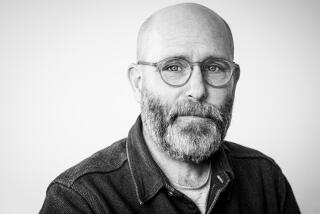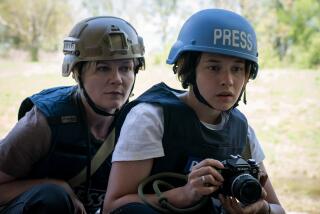On the Afghan Front : Photographs of a soldier’s days serving in the ‘Soviet Vietnam’ are on display at Cal State Northridge, along with his images of a 1991 Moscow coup attempt.
NORTHRIDGE — Vladislav Tamarov, a Russian, was 19 when he was drafted into the Soviet army in April, 1984.
Three and a half months later he was flown to Kabul, Afghanistan, where, according to Soviet government accounts to the folks at home, Soviet soldiers were planting trees and building schools and hospitals. However, Tamarov and the other new recruits were told at boot camp that “we would be defending the southern borders of the Soviet Union, as well as the Afghan revolution,” Tamarov said.
On Tamarov’s first day in Afghanistan, an officer declared that Tamarov would be a mine-sweeper. Ten days later he went on his first combat mission. During his 621 days in Afghanistan, he diligently kept a record of his time in the military, including how many days he had served and how many hours he had left to serve.
He also brought along a camera and took between 600 and 700 photographs. Though there are some images of Afghan soldiers and civilians, most of them are of himself and the other boys of his platoon. They search for mines, stand ready for battles and take part in them, and rest in between. Friends posing for the camera would be dead only hours after some of the pictures were taken.
There were military and other government officials who did not want Tamarov’s photographs to come out of Afghanistan. Twice, his camera was broken. In letters home, he mailed about 80 pictures he considered his best, but they never arrived.
Twenty of his photographs from Afghanistan are on view with 13 images of the 1991 Moscow coup attempt to remove Mikhail Gorbachev from power, in the exhibit “People or Soldiers?: Photographs by Vladislav Tamarov” at Cal State Northridge’s Art Galleries.
The 20 Afghan images and many more have been compiled in Tamarov’s book “Afghanistan: Soviet Vietnam,” published by Mercury House of San Francisco in 1992. Photographs on view in the gallery are accompanied by Tamarov’s text from the book, which relates events surrounding the pictures, and his thoughts and feelings about what he saw and did in Afghanistan.
“Now I’m often asked if I thought the war was a just war when I was there. How can I answer?” Tamarov wrote in the introduction. “I was a boy who was born and raised in quiet, beautiful Leningrad, a boy who loved his parents and went obediently to school. A boy who was yanked out of that life and dumped in a strange land where there was a real war going on, where life followed different rules. And the most important rule was simple: Only those who kill first will survive. There, we didn’t have ‘smart thoughts.’ We shot at those who were shooting at us; we killed those who were killing us.”
A CSUN history professor brought the book to Art Galleries director Louise Lewis. “The U.S.S.R. had just collapsed, and I felt it was timely,” Lewis said. “Clearly the American conscience has not laid to rest our fighting people in Vietnam. I saw a parallel situation.
“The book is the universal statement of the atrocities of war in very touching, psychological terms. The photographs are a good study of the front--the constant fear. My hope is that books such as this are the swan song of man-on-man warfare--of this kind of conflict resolution.”
Tamarov began writing text for his photographs after a Moscow newspaper reporter’s article about Tamarov’s experience in Afghanistan was censored. The story, as printed, focused only on the return home.
“I wanted to tell people what was really going on,” he said. “I wanted to make people feel how I felt, how my friends felt. When I read it, I feel it again.”
Tamarov was encouraged to tell his story in other countries by Vietnam veterans when they came to the Soviet Union to meet with Afghan veterans. After greeting a group of Vietnam vets at the airport, Tamarov wrote: “They were about 20 years older than us, but we picked them out of the crowd at a glance. I don’t even know why. Almost none of them spoke Russian, and only a few of us spoke English. Within five minutes, we knew we had found friends, even more than that--blood brothers by blood. How did we understand each other? I don’t know. But they understood us a lot better than our own people did.”
During the 1991 Moscow coup attempt, Tamarov took pictures of people and how they reacted to events rather than of highly dramatic shots of tanks or soldiers. No text comes with these pictures, since they “speak for themselves,” he said. Relating the first coup attempt and the most recent one to his experiences in the Soviet army, Tamarov said: “Soldiers who have to take orders can be people who care--at the same time, they’re still people. People sometimes don’t care.”
Also, in CSUN’s South Gallery: “Schooling: An Icthyological Perspective,” a neon art installation by sculptor Michael Flechtner. Five life-size neon coelacanths--primitive marine fish, possibly ancestors of land animals--that are suspended from the ceiling appear to swim in a body of water.
Where and When What: “People or Soldiers?: Photographs by Vladislav Tamarov.” Location: CSUN Art Galleries, 18111 Nordhoff St., Northridge. Hours: Noon to 4 p.m. Mondays, 10 a.m. to 4 p.m. Tuesdays through Saturdays. Ends Nov. 20. Price: Free. Parking: $1.75 in student lots weekdays, free Saturday. Call: (818) 885-2226.
More to Read
Sign up for Essential California
The most important California stories and recommendations in your inbox every morning.
You may occasionally receive promotional content from the Los Angeles Times.










